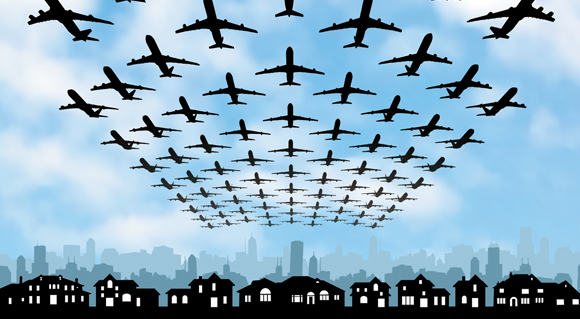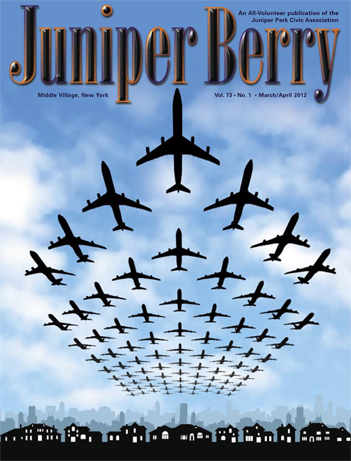Imagine this. A 40-something Middle Village resident holding a football— an average guy in a New York Giants jacket—is shaking his fist angrily at the sky over Juniper Valley Park.
You rush over to him and ask what’s wrong. Under the deafening noise of a low-flying jet heading to LaGuardia he shouts: “The planes! They’re ruining my life!”
When you ask Tony what he means he spills it: “My kid has asthma. And the planes, they fly until 2am, keeping me up. And my family’s been living here our whole life!”
“Calm down, Tony,” you say.
“I can’t calm down anymore! We went to sell our house—to get away from this… this aerial bombardment—but our property value has dropped 25% since the FAA ‘air-space redesign.’ Nobody wants to live in a dirty extension on La Guardia airport.”
Only 60 seconds had passed, but the next jet was already on the attack. “I can’t take it anymore!” Tony cried, hitting his football. “And there are more planes, flying lower every year. If this were a missile, I’d…”
“Don’t do it Tony!” you cry out and rush to tackle him.
But it’s too late. Tony has already hurled his ball toward the droning, pollution-sputtering plane overhead.
Of course the football does nothing. It falls to the ground and the planes continue to crop dust our community.
Okay, so I made Tony up for dramatic purposes. (Sue me.) He’s a composite of the people I’ve talked to since Part I of the Juniper Berry article on the biggest threat to our health, sanity, and sense of community in Middle Village: the FAA and Port Authority’s disastrous decision to break the law and route planes over, right over our homes… instead of over water as they should be.
Here are some of your responses to Part I: Mark in Middle Village called the planes a “plague of locusts” that is growing; Angelina, another reader, wrote that she felt inspired to step up and fight the airplanes for the sake of her kids; and Daniel in Maspeth called this “an outright attack on the residents of this area.”
Daniel then went even further. He observed the flight paths over his house and mapped them out over the course of a month.
He writes: “Maspeth already has what is at best questionable air quality. The preponderance of these low-level fly-overs greatly increases this by saturating the air with toxic jet exhaust. As one plane comes over it leaves a canopy of exhaust toxins, which are forced downward. The result is that toxic exhaust is literally being forced into our homes, which whether we know it or not is actually killing us. I have spoken to some of my relatives and friends who reside in this area and all are experiencing respiratory problems such as headaches, allergies, burning and/or inflamed sinus, asthma, etc. This is not simply seasonal issue of grass and tree pollen. The bottom line is that we humans can’t survive in a toxic atmosphere, and that is exactly what these planes are creating.”
Well said Daniel.
I too have observed my Middle Village home getting nailed with the LGA flight path an average of five out of seven days a week (once I clocked nine days straight with hardly a break). On some days there are over 800 of them passing over our homes from about 6:30 a.m. to as late as 2:30 a.m.
(Hint: It’s easy to educate yourself on the air traffic monitoring site, Passur, on-line for free. Just go to http://www4.passur.com/lga.html and see where the planes into LaGuardia are flying in real time.)
And that brings us to the best kept secret: It doesn’t have to be this way.
There’s a simple solution: An equitable sharing of flight paths. We need to push for a reasonable average of one day a week of the flight path over our community. On the other days, it goes over water whenever possible, or when not possible, over other communities. Is sharing the burden too much to ask?
Now, I’ve noticed there are still several myths bouncing around that need to be addressed. Five to be exact.
Myth One: The planes are not really that bad for me.
A typical 737 weighs 875,000 pounds fully loaded. It flies only 1,000 to 1,500 feet above your kids’ head. Is that safe? Eight-hundred of them passing over your home in a day? Indeed, in 1960, two airplanes collided in midair over Staten Island. One, a United Airlines DC-8 from Chicago heading to what is now JFK, smashed into buildings in Sterling Place in Brooklyn. Next time you see one passing over our community, consider that.
Also, the fuel that LaGuardia Airport admits gets dropped on us contains carbon monoxide, ozone, nitrogen oxides, and volatile organic compounds. According to an array of studies the public health impact of jet air-pollution may include respiratory problems, flu-like symptoms, allergies, chronic raspy or sore throat, and eye and skin irritations and asthma, of course.
Myth Two: My property value is safe.
Think again. A document prepared by Randall Bell of the Appraisal Institute of America talks about the effects of aircraft noise on property values and how much you can expect your home value to drop as a result of it. His report titled “The Impact of Airport Noise on Residential Real Estate” and is available for free download. It shows that property values drop by as much as 22.5% in neighborhoods impacted by aircraft noise. (Incidentally, the report also shows that suicides doubled for people between 45 and 54 who are subjected to regular aircraft noise and cardiovascular disease increased 18%.) Also, the NDSI (Noise Depreciation Sensitivity Index) indicates a one percent loss in property value per one-decibel increase in noise. Oops, there goes the neighborhood.
Myth Three:C’mon noise isn’t that bad. It’s a city after all.
Elevated noise from airplanes can cause hearing impairment, hypertension, ischemic heart disease, annoyance, sleep disturbance, and decreased school performance. Airplane noise can also create stress, and increase aggression and other anti-social behaviors. (Remember good old Tony?) And a number of studies have shown that aircraft noise exposure impairs cognitive performance in school children.
The New York City Sound Code puts the limit of continuous and repetitive outdoor noise at 45 decibels. A homeowner or businesses that produces repetitive continuous sound in excess of that gets fined. Why aren’t the government authorities inundating us with these planes getting fined every day of the week?
Bedford-Stuyvesant—where the planes are still much higher up in the same flight path that passes us—experiences DNL levels as high as 85 decibels. Park Slope experiences normal decibel levels in excess of 85 much of the time. Aircraft flying overhead producing decibel levels in excess of 80 dBa every 70-90 seconds is considered repetitive and continuous.
Evidence suggests that here in Middle Village levels are likely above 100dBa since the planes are 1000 feet or less above us when they reach here. We are way behind our Brooklyn neighbors (see Brooklyn Quiet Skies, for example) and urgently need someone to measure it to show the authorities they’re breaking the law. Any volunteers?
Myth Four: The FAA and Port Authority know what’s best for us and are looking out for our best interests.
Unfortunately these institutions get heavy pressure from industry to get more planes into LaGuardia as fast as possible and little pressure from us homeowners to give us a break.
Brooklyn resident and pilot Jeffery Starin says in The Brooklyn Paper: “There is not a lot of oversight of the FAA because of how technical it is — they pull the wool over people’s eyes. But I’m a pilot, they can’t do that to me.” He says that the drastic change in air traffic over Middle Village is a result of the “airspace redesign” initiated by the FAA in 2007 as a way to— supposedly— relieve airport delays. Planes bound for LaGuardia that once arrived in a “fan pattern” now are consolidated into one corridor stretching from Brooklyn, along the Long Island Expressway, and then right over Middle Village and Maspeth. Passur confirms that roughly every ninety airplanes are using the same flight path that passes over us. The FAA and Port Authority are breaking the law, specifically numerous subsections of the National Environmental Policy Act Order 1050.1E.
Myth Five: Might as well oppose earthquakes as oppose flight paths. We can’t fight the FAA.
I’m sorry, but was that a challenge? We the residents of our Queens communities who have won so many victories through the JPCA can show we can also break through these five myths and beat this.
There’s just a simple thing we want: an equitable sharing of flight path disturbance to our lives. We want a reasonable average of one day a week of the flight path over us. On the other days, it goes over water or elsewhere. Now is that so hard?
Unfortunately the squeaky wheel gets the grease, and communities in Nassau, Brooklyn, and elsewhere are already organized into community groups that push hard to get the planes out of their backyards. As long as we’re silent, guess who’s going to get more planes when re-routing decisions come?
We all need to get together to do this. But if not us who? And if not now when?
The box below has five things YOU can do. We can stop the drop in our property values and create a peaceful sense of neighborliness, uninterrupted by the dangers of jet noise and pollution.
Five things you can do now to stop the crop-dusting of our homes and kids:
1. Look and Listen. Next time you’re walking outside, be aware of the planes. Ask yourself: Has it always been like this? Is this acceptable? Could the threat increase?
2. The onus is on us to contact our other elected officials and tell them: We want less airplanes and less pollution. One day a week maximum over our area.
3. We should form a Juniper Valley Clean and Quiet Skies group to discuss options to move this forward through these steps. If you’d like to join write me at bill@williampowersbooks.com and I’ll create a list.
4. Any youth leaders looking for a community service project (to help get you into Yale)? Want help lead this campaign for Clean and Quiet Skies?
5. We need people who are interested in taking sound decibel readings using an inexpensive digital recorder ($200 if anyone would like to contribute one or has one, it is welcome). We’d then collect data and publish it on the JPCA site to prove to the FAA, Port Authority and legislators that the FAA and Port are in violation of the National Environmental Policy Act.




